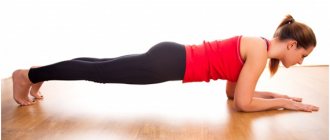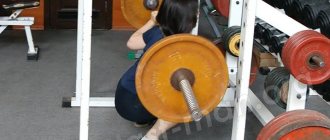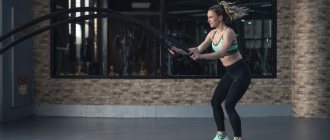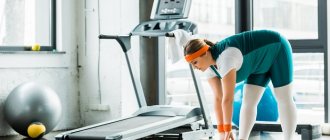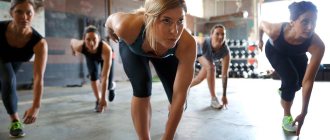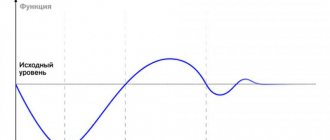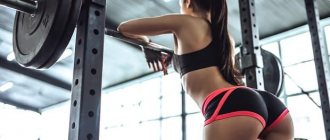- August 3, 2018
- Workouts in the gym
- Iminany
What is a hernia? This is a disease in which some fragments or the entire intervertebral disc prolapses or protrudes into the canal of the spinal cord. Because of this, the nerve tissue is compressed, and the person begins to feel constant pain at the site of formation. If there is a hernia in the lower back, there will be stiffness when moving and acute pain when turning the body, which can often radiate to the leg and cause numbness in the limbs.
With inactivity, the hernia will certainly progress, so the patient should consult a doctor before starting training. Correctly dosed physical activity under the supervision of an instructor will give a person the opportunity to reduce the impact of symptoms on health and remain active.
Hernias, like protrusions, located in absolutely any part of the spine, require constant and painstaking work to reduce their negative consequences. One of the important exercises in the treatment of a hernia is stretching, which is perfectly represented in yoga therapy. In general, a large percentage of a person’s health depends on his flexibility, because well-trained spinal muscles can support our main core in the body for many years.
Misconceptions
In fact, a hernia can occur due to muscle spasm. How? There will be uneven tension in the short muscles on the sides of the spine and pressure will go to the intervertebral disc. But the important point is that the hernia itself cannot hurt, since pain receptors do not pass through it, that is, the brain does not receive a warning signal. But everyone is used to thinking exactly the opposite.
One of the most common misconceptions is that a herniated disc can be caused by an unsuccessful and sudden jerk of something heavy, but this is not entirely true. Such an action will only lead to the initiation of a hernia. And the main reason is a violation of the load distribution in the muscular balance of the spinal frame. This is why back injuries often occur in beginners in a particular sport (especially those associated with strength training). The muscles of the newcomers are developed spasmodically.
Treatment prognosis
The effectiveness of treatment, both conservative and surgical, directly depends on how accurately the patient follows medical recommendations. Also, the likelihood of relapse depends on the nature of the operation performed. With complete removal of the disc in one way or another, there is no risk of recurrence of the hernia in the same place, but it can form in adjacent spinal motion segments.
On average, the relapse rate after surgical treatment of hernias is 11.5%. But most often they are formed in other PDS.
Basic principles of training for spinal hernias
The training process has several important nuances that must be taken into account by all people who have an intervertebral hernia or are located in absolutely any part of the hernia, especially in the lumbar region. It is the very lower part of the back that is subject to the greatest load due to its natural lordosis or arching. The main limitation in training will be the axial load on the lumbosacral area.
All exercises with a herniated spine in the gym should be performed without bending over with weights, deadlifts and lunges with a barbell, as this will only increase the load on the lower part and further bend the lower back affected by the disease. But the most desirable exercise would be stretching. If you have a herniated disc, it is stretching training that strengthens the extensor vertebral and gluteal muscles that will help relieve symptoms. Plus, in gyms you can attend yoga classes, which is an excellent panacea for many diseases of the spine.
Contraindications to physical therapy
There are cases when physical therapy is contraindicated. Among them are:
- oncological diseases;
- stroke;
- pre-infarction condition;
- diseases accompanied by elevated body temperature;
- exacerbation of intervertebral hernia;
- hypertensive crisis;
- if a little time has passed since surgery.
What can you do?
Exercises with a herniated spine in the gym should be designed without axial loads, which are performed in a sitting or lying position. For example, in the gym you should not perform bench presses, deadlifts, or biceps/triceps training exercises while in a seated position. If the hernia is small, then leg presses are allowed.
An important condition when performing exercises with a herniated spine in the gym is to perform hyperextension after training, only lying on the floor, and not using a machine. The best option would be to perform static hyperextension. For example, lie on your stomach, stretch out your limbs and, lifting the front and back parts of the body from the floor, hold it in this position for one minute, gradually increasing the time to five minutes.
If a set of exercises for a herniated spine is performed correctly, then the condition will not worsen. It’s worth repeating once again that you need to exclude all squats, deadlifts and lunges with a barbell.
Pain intensity
If the patient suspects that he has a herniated lumbar disc, then appropriate treatment is prescribed only after confirmation of the symptoms. As mentioned above, the main symptom of the disease is pain. Most often he is of a dull nature. Increased discomfort can be observed after a person remains in one position for a long time. Temporary relief comes from changing the position of the body.
It is a mistake to assume that a lumbar disc herniation is a passing phenomenon and to delay treatment. Over time, the disease can become more progressive, causing multiple pinching of nerve endings.
Over time, the pain syndrome can be localized in the gluteal area or accompanied by lumbago in the lower back. This process is called sciatica.
When is a complete ban on classes implemented?
Exercises with a herniated spine in the gym are strictly prohibited if you have:
- Severe pain or severe stiffness, that is, in those moments when a person becomes partially immobile.
- Severe and obvious inflammation, swelling, disturbances in the functioning of the lymphatic fluid.
- Transition of the hernia to the terminal stage.
- Additional diseases associated with the musculoskeletal system, for example, osteochondrosis, arthritis, arthrosis.
- Negative consequences after training with a herniated spine in the gym. You should not do exercises with force when you are in pain.
- Weakness that occurs with atrophy of the back muscles. In this case, the compensatory system of the spine begins to work incorrectly, because muscles are the main insurance for the spinal column.
- Rehabilitation after surgery on spinal tissues.
Why do you need to do exercises at all?
The wide-grip bench press is usually performed to build muscle, lose weight, and achieve endurance, but not when a person has a herniated disc. Although you will still need good muscle endurance.
The main goal of physical exercise for a herniated disc is to strengthen the muscle corset that supports the spinal column and the entire back as a whole. With good stabilization of the spine, the symptoms of the problem will be reduced significantly.
Stages of the disease
Lumbar spinal hernia is characterized by different signs at certain stages of disease progression. Currently, each patient has the opportunity to stop the development of the disease and prevent the risk of serious consequences, as well as to treat a hernia of the lumbar spine without surgery , for this it is necessary to visit a competent specialist in a timely manner. Below we will talk about the main stages characteristic of this pathology:
- Prolapse. In this case, there is a slight change in the position of the disk. There is a possibility of its return to its usual place, subject to the cessation of the negative impact;
- Protrusion. There is a strong displacement of the location of the disc, but it does not protrude beyond the boundaries of the vertebrae;
- Extrusion. The nucleus is displaced beyond the boundaries of the vertebrae;
- Sequestration. It is characterized by the appearance of cracks in the area of the fibrous ring. In this case, there is a displacement of the pulp beyond the line marked by the vertebrae.
What happens during exercise?
Firstly, the compensatory muscles, which are the main holders of the entire load on the spine, are strengthened. In fact, this is one of the most important points related to the health of the entire body, because these muscles distribute more than thirty percent of the total load carried by the spinal column.
Secondly, the spinal column is aligned, which, with prolonged exposure to pathology in the form of a hernia, is subject to deformation and destabilization. This factor also greatly influences how the load is distributed across the back. The curvature of the spine does not allow it to expend the energy it receives efficiently and, accordingly, becomes even more deformed.
Basic rules for training
Absolutely all the rules for patients with a vertebral hernia must be followed without additional questions, because this is their health. By ignoring the instructor's advice regarding what exercises cannot be performed with a herniated disc, a person may simply remain disabled due to his own negligence.
What is included in the inflexible rules:
- If pain appears anywhere, you should immediately stop doing the exercise, or maybe the entire workout. If the pain does not stop, then this exercise is excluded or replaced with a more gentle one.
- Completely eliminate any twisting, since during their implementation an axial and rotational load is applied to the spine.
- Sudden movements and shock loads on the entire back, including soft tissues, are excluded. All exercises are performed in calm, slowly entering one or another pose is practiced (especially in yoga).
- The training should proceed smoothly, that is, only after learning the basic and simplest exercises, you can move on to more complex ones. The load should not increase in one day, but over a couple of weeks.
- It is forbidden to lift too heavy projectiles (even taking into account the safety net). The weight should be selected by the trainer, since in almost all exercises the weight will affect the work of the back muscles.
- Before each lesson, you should first warm up and stretch the ligaments and muscles.
General recommendations
Don't overload your back. Under no circumstances should you carry heavy bags over long distances, load cabinets, unload trucks with cement, etc. In this case, you cannot avoid back pain and aggravation of the problem situation.
Sit less. While sitting, the spine experiences enormous stress. If you have a sedentary job, get up from your chair from time to time to walk a little and do a light workout. This will relieve tension from the spine. In addition, warming up will help normalize blood circulation in the body.
If possible, eliminate running and jumping from your life. As you run, with each step, the weight of your body, multiplied by the acceleration of free fall, falls on your spine. When you jump, the load increases significantly.
Three basic exercises for healthy people
The main exercises are the press, deadlift and squat. Many patients with hernias can perform the bench press as an exercise while lying on their back, but the bar should be used bare, without weights. This way the load on the spine will be minimal.
Deadlifts are also performed with an empty bar, but squats, even with an empty bar, should be avoided. When squatting, the main load goes to the lower back, but even if the hernia is not located in this part of the back, the barbell still needs to be eliminated and squats performed as usual, without auxiliary elements.
Prevention
To reduce the likelihood of a hernia forming or reoccurring, it is important to make lifestyle changes. First of all you should:
- stop smoking and minimize the amount of alcohol consumed;
- do exercise therapy and stretching exercises daily;
- undergo a course of manual therapy twice a year;
- avoid stress and change your attitude towards stressful situations;
- sleep at least 7–8 hours;
- wear high-heeled shoes no more than 2 hours a day;
- visit the pool twice a week;
- balance your diet, give up unhealthy foods and adhere to a normal drinking regime (at least 1.5 liters of water per day);
- take vitamins, especially group B and unsaturated fatty acids (Omega-3).
What exercises should you do if you have a herniated disc?
Since the basic exercises are already clear, we should look at those that have a direct effect in eliminating a hernia. Here are the exercises allowed for patients with spinal hernias:
- Any exercise with dumbbells. This can include lunges with swings. Dumbbells have a very good effect on the abdominal press; exercises in a supine position are suitable here.
- Pull-ups. In general, the benefits of pull-ups on the horizontal bar need to be discussed separately, since in this position the spine is stretched, trying to take its original shape (in case of deformation).
- Rows and presses with an empty bar.
- Strengthens the biceps with minimal additional weight. Otherwise, the back muscles will also be involved in the work, which will not help improve the position (not to be confused with special exercises aimed at strengthening the back muscles).
- Strengthening the triceps muscles should also be done with as little additional weight as possible. The arms can be extended in a block simulator, but it is better not to perform the French press in a standing position, as well as extension of the arms with dumbbells from behind the head due to the incorrect vertical load on the spinal column with a hernia.
- Exercises aimed at the leg muscles can be performed both lying down and sitting, that is, bending, extending, abducting and spreading the legs, thereby increasing the power of the calves.
- Strengthening the shoulder muscles occurs on exercise machines that exclude free weights (raises and arm raises).
Of course, the list is not very diverse, but by performing all the above exercises under the supervision of an instructor, you can achieve progress not only in maintaining body shape, but also in treating a herniated disc.
How to help yourself?
At the initial stage of treatment, it is better to seek help from a special physical therapy center. Under the supervision of professionals, exercises will form the stability of the spine by creating a muscular frame, improve blood movement, and relieve muscle spasms. During exercise, the spine is stabilized, that is, the possibility of relapse of the disease is reduced, the vertebrae take a physiologically correct position. A combination of different types of training will give a positive effect and relieve the patient from pain. Exercises will restore your posture and normalize your back muscles.
Particular attention should be paid to spinal hyperextension, which gives excellent results.
Correct actions when a hernia is detected
The patient himself should never personally determine the training program. All exercise in the gym with a spinal hernia is possible only after careful consultation with your doctor. But it is worth noting that such a mix of programs (simultaneous treatment and beauty enhancement) is impossible. And for people with a hernia, the best option would be to choose a treatment complex.
An important point is that the instructor has a medical education. Of course, these days it’s difficult to find someone like that, because everyone who doesn’t get hired becomes a coach, profiting from the money of their players. Then it is worth considering the options of instructors who have already dealt with injuries. It is also worth knowing that trainers working in general groups and having the education of rehabilitation specialists (this is not an education in the medical field) do not have the right to create such programs for the treatment of vertebral hernia. The ideal option would be to have your doctor approve the program compiled by the trainer.
